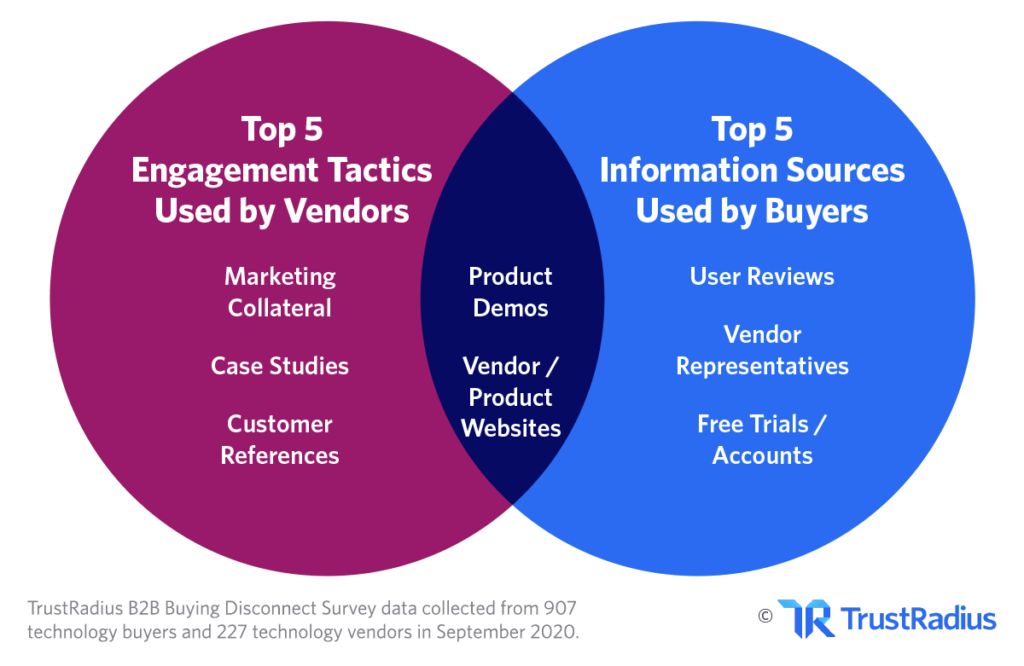Expert Insights From The 2021 B2B Buying Disconnect
When we launched the biggest B2B report of 2021, the B2B Buying Disconnect, we knew our readers want even more expert insights.
That’s why our founder and CEO Vinay Bhagat invited two of the sharpest minds in B2B marketing to share actionable insights:
Elissa Fink
Board Member, CMO Advisor, and Former CMO of Tableau Software
Samantha Stone
Founder & CMO of The Marketing Advisory Network
Below you’ll find 5 hot takes from these experts:
- How millennial buyers demand self-service options
- Which resources buyers actually trust
- Where SaaS vendors totally miss the mark
- Reviews have more influence than you think
- Intent data is more than just a buzzword
Want to see the conversation live? You can download the video recording and the full slide deck here. It’s free.
Millennial Buyers Demand Self-Service Options
Today’s buyers want information, and they want it quickly. They want to have full control over their buyer journey, without having to jump through marketing and sales hoops.
That’s because 60% of B2B tech buyers today are millennials, and they do things a little differently.

Still, that doesn’t mean millennials want to cut out all interactions from sales and marketing. Like Elissa mentions in the video clip above, most people resort to self-serve options because they’re tired of trying to get purchasing information from traditional sources.
If you make it easier for potential buyers to access helpful information, you can accelerate the sales process and increase overall customer satisfaction.
This means you should consider providing ungated access to unbiased customer reviews, high-level demos, and ballpark pricing. That way millennial buyers can self serve their way deeper into your funnel.
These Are The Resources Buyers Actually Trust
Let’s face it: Buyers trust everything that’s not vendor corporate marketing. They want resources they can interact with on their own—think self-driven demos, reviews, and free trials.
That’s why those resources rank really high in both trustworthiness and influence:

If you’re selling software, one thing you can do to build more trust is to provide content, reviews, and examples that are specifically targeted to your key personas.
Buyers want to find examples that match their story on your site. Helping buyers “find themselves” is key.
Where Vendors Totally Miss the Mark
In the chart below you can clearly see the disconnect between which information sources buyers actually use, and what vendors THINK they use.

This isn’t to say that “marketing collateral” and “case studies” aren’t important to buyers. Sometimes they can be really useful.
However, you should consider focusing less on traditional resources like these and investing more into the resources buyers actually use—like reviews and self-serve options.
Reviews Have More Influence Than You Think
The term “dark funnel” is trending right now in marketing land, and for good reason. This term for describes all of the potential buyers that are aware of you, but that you never see. They subvert the traditional “buyer’s journey” and make buying decisions that we marketers have no insight into.
The same concept applies to reviews, but in a more positive way.
In a typical buying committee, one member (if not all of them) will likely read reviews. And those who read reviews are almost guaranteed to share them.

This data shows that 92% of buyers who rely on reviews also share those reviews with their collaborators. It makes sense. We all look at reviews before choosing a restaurant or a product on Amazon—why wouldn’t we do the same when purchasing business software?
Are you ready to grow your review program? Sign up for a TrustRadius demo and give your buyers the authentic reviews they’re already searching for.
Intent Data is More than Just a Buzzword
Intent data is an incredibly powerful marketing strategy, but there’s still a lot of confusion around how to use it.
According to data from the B2B Buying Disconnect, only 40% of tech vendors work with an intent data provider right now. If you’re not using intent data, you’re missing out on a potentially BIG competitive advantage.

About a third of vendors still don’t use intent data at all. But of those that do, a majority (61%) have increased their investment this past year.
Here’s how they’re using it: 70% of these vendors use intent data for prospecting, which is the most basic use case. But others use intent data for supporting sales enablement and optimizing their ABM spend by targeting the right accounts.

There’s also a large number of vendors who work with review websites like TrustRadius but haven’t taken advantage of the lower-funnel intent data that we generate. Only 26% of vendors who use review websites leverage them to obtain intent data.
Review sites could be your intent data secret weapon—or a gateway to a whole new pipeline for your company in 2021.
If You Only Remember Four Things…
After all the tips, advice, and data we just shared, here are four key takeaways to remember:
- Tailor your marketing to millennials, who are the new majority.
- Invest in the resources that buyers actually trust (like unbiased customer reviews).
- Embrace self-service options at all stages of the buyer’s journey.
- Chart a course to strategically use intent data for lead generation.
Looking for more insights like this? Click here to see other digital events that feature the best minds in marketing and customer voice.




